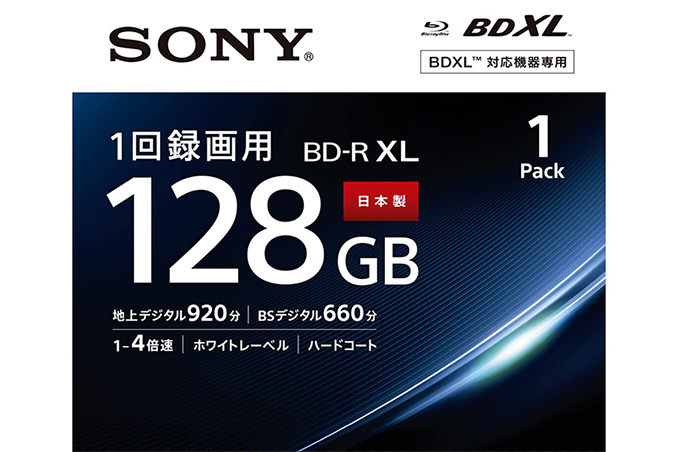Sony Releases Quad-Layer 128 GB BD-R XL Media
by Anton Shilov on November 9, 2018 1:00 PM EST
Sony is about to start selling the industry’s first 128 GB write-once BD-R XL optical media. The discs will also be the first quad-layer BDXL media formally aimed at consumers, but bringing benefits to professionals that use BDXL today.
Although the general BDXL specifications were announced back in 2010 for multi-layered write-once discs with 25 GB and 33.4 GB layers, only triple-layer BDXL discs with a 100 GB capacity (generally aimed at broadcasting, medical, and document imaging industries) have been made available so far. By contrast, quad-layer 128 GB media has never seen the light of day until now.
As it turns out, increasing the per-layer capacity of Blu-ray discs (BDs) to 33.4 GB via a technology called MLSE (Maximum Likelihood Sequence Estimation) was not a big problem, and most of today’s BD players and optical drives support the BDXL standard. However, increasing the layer count to four while ensuring a broad compatibility, signal quality across four layers, yields, and some other factors slow downed release of 128 GB BDXL essentially by eight years.
In a bid to build a viable quad-layer 128 GB write-once BDXL disc, Sony had to design three new materials. First, the company had to create a new recording alloy that would provide the right combination of reflectance and transmittance to ensure that the layers can “reflect” data bits when needed while allowing the 405nm laser to pass through them when another layer is accessed. Then, Sony had to develop a new inter-layer material (called dielectric) that would also be able to transmit light waves. Finally, because with four layers the first one has to be located closer to the disc’s surface, Sony had to design a new protective coating for the media.
Sony will start shipments of its BD-R XL 128 GB media on the 10th of November. Single-disc packages (BNR4VAPJ4) will retail for ¥1,500 ($13), a pack of three (3BNR4VAPS4) will cost ¥3,900 ($34), whereas a pack of five (5BNR4VAPS4) will be priced at ¥6,000 ($53). The discs should be compatible with drives supporting the BDXL spec, though a firmware update may be needed regardless.
Related Reading:










44 Comments
View All Comments
AdditionalPylons - Wednesday, November 14, 2018 - link
I wanted to post something similar. Just did a price comparison of current BD-R vs HD. BD-R is more expensive. I'm in Norway, but I guess prices are similar in other places.S-ATA HDD: 0.26 NOK/TB
BD-R 25GB: 0.28 NOK/TB
BR-R 50GB: 0.43 NOK/TB
BR-R XL 100GB: 1.0 NOK/TB
100GB medium is already four times more expensive per TB than hard drives, is read-only, and that does not include the cost of any burner. I doubt 128GB discs would be any cheaper.
I do understand that they're not mainly trying to compete with HDD, but that also means they will never reach consumers, which I first thought was the point with this launch.
For the few use cases when a HDD is too heavy (e.g. sending in the mail, or carrying with you all day) I assume a flash or memory card would work better, and can be re-used.
Darcey R. Epperly - Saturday, November 10, 2018 - link
128 GB is not enough. 1 TB or 10 TB per disc, that would be a good backup media.trackersoft - Saturday, November 10, 2018 - link
SONY ODA format is on the market for long time now.It is basically cartridge with multiple 128GB BDR(E)XL discs.
The reason why SONY decided now (after so many years) to bring 128GB discs to "mass" market is most probably lack of interest by enterprise segment...